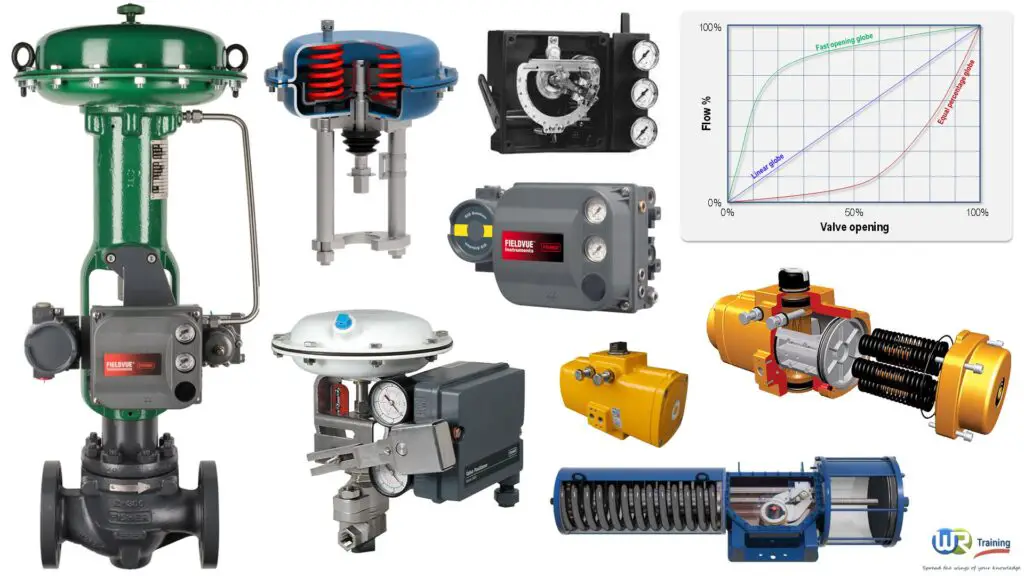3.5 HOURS ON-DEMAND VIDEO
ACCESS ON MOBILE AND TV
FULL LIFETIME ACCESS
30-DAY MONEY-BACK GUARANTEED
ABOUT THIS ONLINE COURSE
This course is for engineers, valve mechanics, maintenance personnel, instrument technicians and other persons responsible for the selection, sizing, installation, commissioning, operation and maintenance of control valves, actuators and positioners.
The course begins with a review of the role and function of control valves and actuators and offers a technical perspective for the working of positioners for control valve operation.
You will find valuable insights into the working principles and construction details of the following equipment:
control valves (sliding stem and rotary / fast opening, linear and equal percentage)
mixing and diverting 3-port control valves
diaphragm actuators (air-to-push-up and air-to-push-down)
piston actuators (single acting and double acting / Fail Open (FO) and Fail Close (FC))
rack and pinion actuators (single acting and double acting / Fail Open (FO) and Fail Close (FC))
scotch yoke actuators (single acting and double acting / Fail Open (FO) and Fail Close (FC))
pneumatic positioners (force balance, motion balance)
digital positioners
I/P converters
The course then proceeds through a series of process examples and solved problems that require you to:
dismantle and assemble various types of control valves and actuators using 3D and 2D models
identify the net effect of various control valve/actuator assemblies (direct acting, reverse acting, fail open, fail close…)
convert an actuator from single acting to double acting configuration
convert a control valve/actuator assembly from a fail close to a fail open configuration
construct the installation curve for a control valve
determine flowrate and pressure drop through control valves for different valve lifts
match the valve characteristics to the given application
examine the effect of selecting a control valve larger than necessary
examine the effect of differential pressure on the valve lift and actuator operation
determine when a positioner should be fitted
…
This will help you develop the necessary skills to ensure your process plant and piping systems run smoothly.
The course also includes:
extensive graphics
cross-sectional views
3D animations
This will give you a virtual practical exposure on control valves, actuators and positioners.
We promise you that even though this is a technical training, you can watch it easily, without pain, but with comprehension, and that after completing it, you won’t be an experienced process control engineer or instrument technician but you will be prepared to become one if that is what you like and persist to be.
- Understand control valves working principles for successful operation of your plant and piping systems
- Understand control valve construction details (bonnet, stem, disc, seat, packing, body, actuator, positioner…)
- Identify and know the principles of operation of common control valve actuators (diaphragm, piston, rack and pinion, scotch yoke)
- Dismantle and assemble various types of control valves and actuators using 3D and 2D models
- Understand how single acting and double acting pneumatic actuators work through graphics and 3D animations
- Know how to convert a single acting spring return actuator to a double acting actuator and vice versa
- Understand the concept of failure mode in control valves : Fail Open “FO”, Fail Closed “FC”, Fail As Is “FAI”
- Understand the concept of “Air-to-push-up” and Air-to-push-down”
- Understand the concept of “direct-acting” and “reverse-acting”
- Know how to convert a fail close actuator to a fail open actuator and vice versa
- Understand the concept of valve flow coefficient “Cv” and familiarize yourself with the various units
- Know how to determine flowrate and pressure drop through control valves for different valve lifts
- Know how to match the valve characteristics to the process
- Know how to construct the installation curve for a given control valve
- Understand the effect of selecting a control valve larger than necessary
- Understand the effect of differential pressure on the valve lift and actuator operation
- Differentiate between fast opening, linear and equal percentage valve characteristics
- Understand how valve positioners operate
- Know the different types of valve positioners (P/P, I/P, force balance, motion balance, digital…)
- Understand when a positioner should be fitted
- Understand the working principles of I/P converters and how they are used in control valves
- Chemical / Process / Control Engineers
- Design Engineers
- Piping Engineers
- Plant Engineers
- Maintenance / Instrument Technicians
- Mechanics
- Plant Operators
Some engineering or field knowledge is preferable but not mandatory. All the concepts are explained in depth using an-easy-to-understand language to allow students to build their knowledge from the ground up
Our clients say
Would you like to contact us or to book a Live Virtual Training or In-House training in your premises ? We are here to help !
Fore more information, please fill in the contact form hereafter then click on send :


